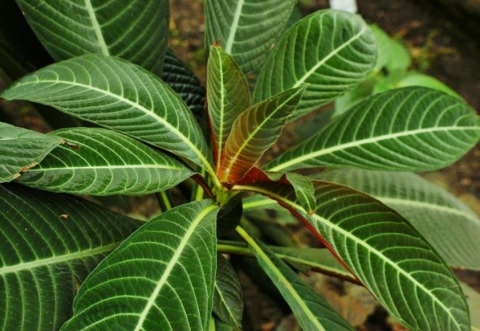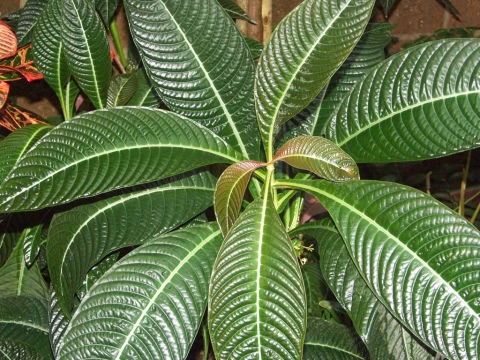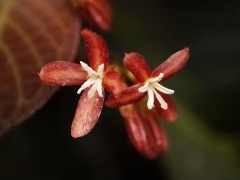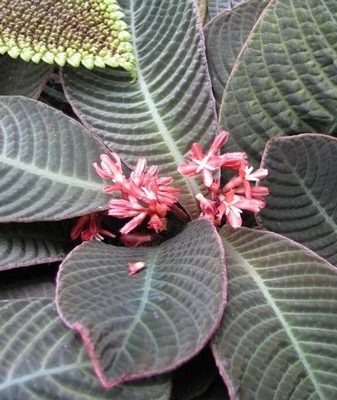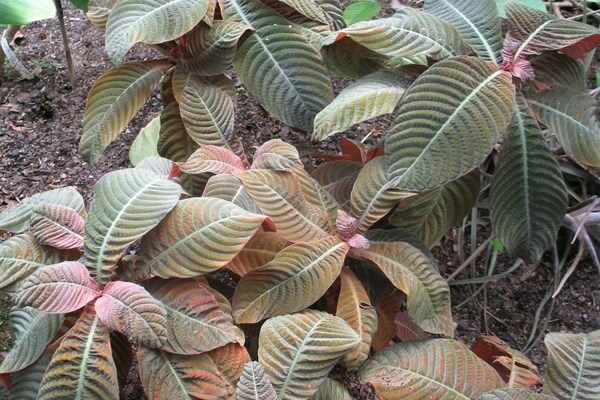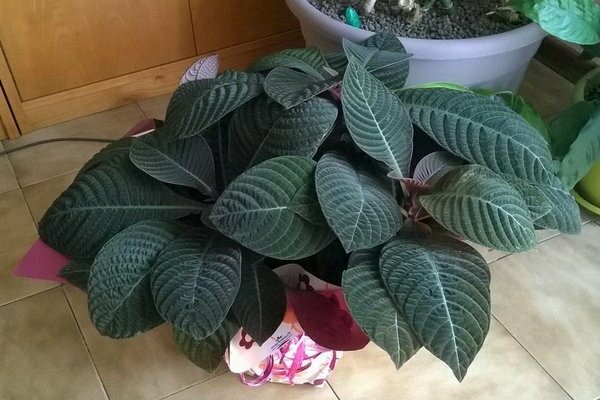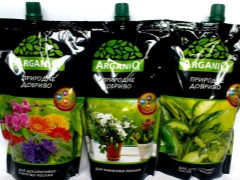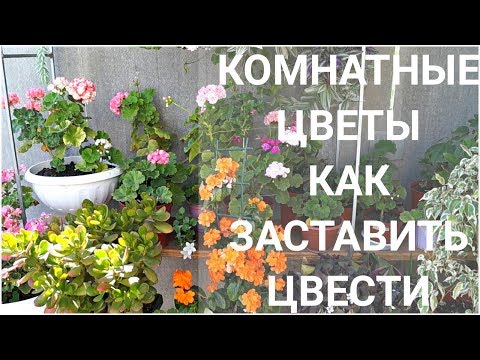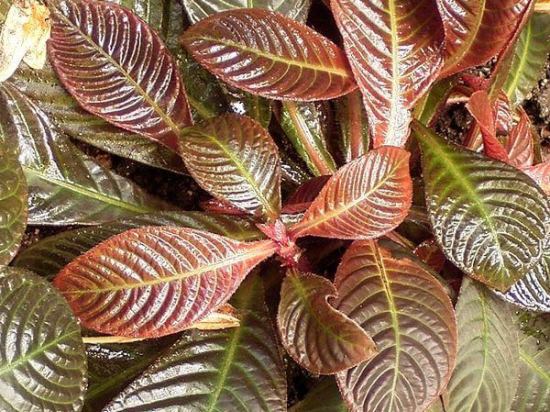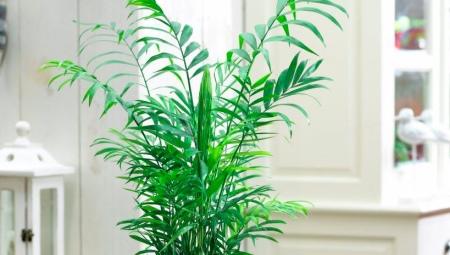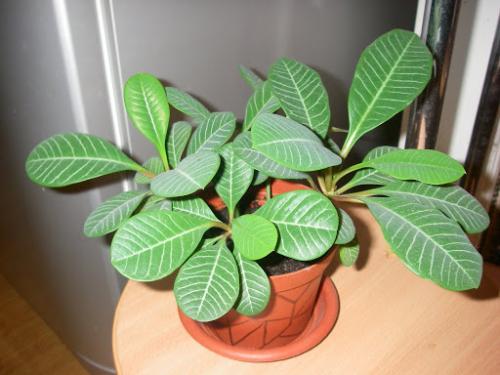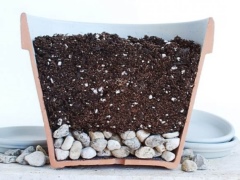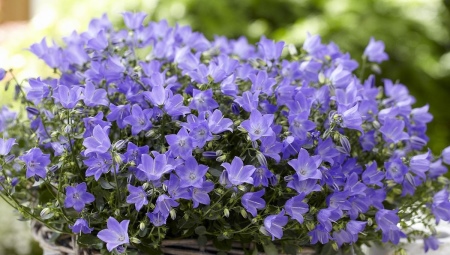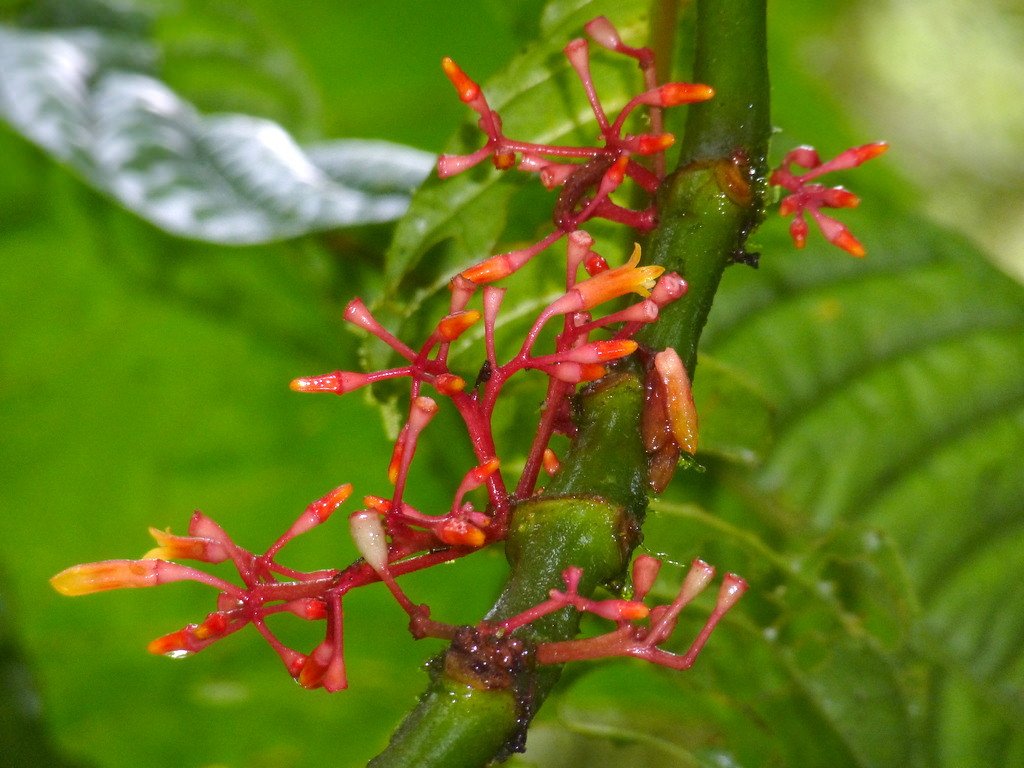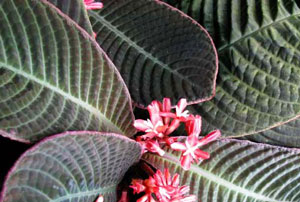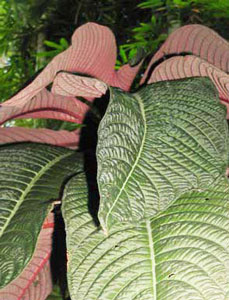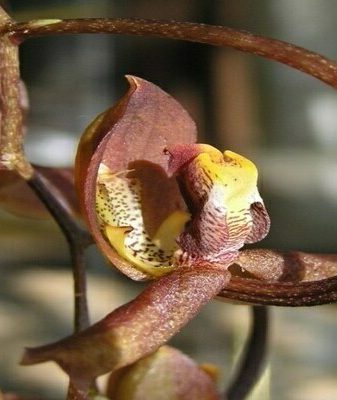Views
Despite the variety of Hoffmania types, only a few are considered cultural.
Shining
Some gardeners call this type of hoffmania "glittering". In its shape, it resembles a low shrub, the height of which is within 30-60 centimeters. Its stems grow straight and are red in color. The length of satin leaves reaches 10 centimeters. The top of the leaves is olive green and the bottom is red. After a certain period of time, small inflorescences consisting of red flowers appear on this plant. They appear right on the surface of the trunk. The diameter of these flowers is 2.5 cm.

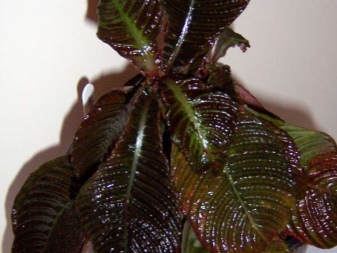
Velvet (Retzlya)
The height of the stems of this type of goffmania is 30 centimeters. They are quite fleshy, have four edges and a red tint. The velvety leaves of this flower are slightly pointed from above, but slightly elongated at the base. Their length is 20 centimeters, and their width is 10 centimeters. The top of the leaves is olive green and the bottom is brownish red. The red flowers are collected in small, cyst-like inflorescences.
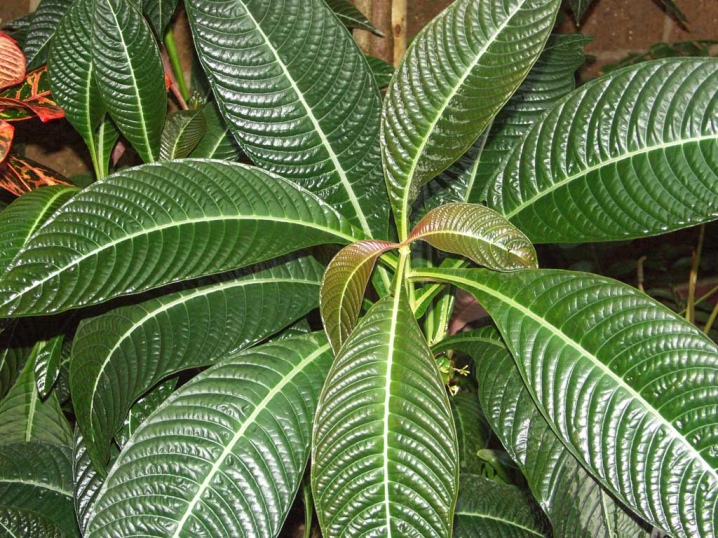
Goffmania Gisbrecht
Another type of hoffmania, which is in the form of a bush. Its velvety leaves are large enough and have a bright green tint on top. They are pink underneath. The flowers are also star-shaped. Most often, such a plant is grown in greenhouses.

Planting ludisia: pots and substrates
Under indoor conditions, ludisia can be grown in ordinary flower pots or planted in florariums. In both cases, for planting them, you need to use a special substrate, which is compiled independently from the following components:
| Substrate variant | Leaf land | Sod land | Coarse peat | Fern roots | Semi-ripe leaves | Agroperlite |
| №1 | 3 parts | – | 1 part | – | – | 1 part |
| №2 | – | 3 parts | – | 1 part | 2 parts | |
| №3 | 2 parts | 2 parts | 1 part | – | – | 1 part |
Ludisia pots are selected not too high, but wide, which will allow the bush to grow in breadth. This plant has a creeping and in turn branching rhizome-rhizome, and it needs to be allowed to grow. There must be holes in the bottom of the pot for water drainage. For optimal drainage of the substrate, a layer of fine expanded clay is laid under it.
Planting ludisia in the florarium also implies the creation of drainage. Since there are usually no lower holes in glass containers, the expanded clay layer should be made higher.
 Since ludisia have creeping shoots, some growers grow these orchids as loose bushes in suspension, using them as ampelous. Without flowers, ampelous ludisias may resemble Tradescantia, but during the flowering period, belonging to the orchid family becomes obvious.
Since ludisia have creeping shoots, some growers grow these orchids as loose bushes in suspension, using them as ampelous. Without flowers, ampelous ludisias may resemble Tradescantia, but during the flowering period, belonging to the orchid family becomes obvious.
Peculiarities
Goffmania belongs to the Marenov family. The birthplace of the flower is South and Central America.
Leaves are the main decoration of this flower. They are dark green below and bright red above. The length of one sheet in some cases reaches 30 centimeters, and the width - up to 8 centimeters. Some of the species can form a rosette. In this case, young leaves are colored reddish.
Such indoor plants can be decorated with flowers, the shape of which resembles a star in its appearance. By themselves, they are small and mostly hidden under the leaves. Their color is most often yellow, and there is a small red spot in the middle.
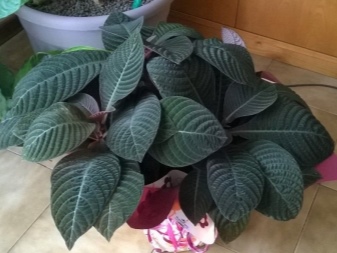

Despite the variety of types of hoffmania, only a few are considered cultural.
Shining
Some gardeners call this type of hoffmania "glittering". In its shape, it resembles a low shrub, the height of which is within 30-60 centimeters. Its stems grow straight and are red in color.The length of satin leaves reaches 10 centimeters. The top of the leaves is olive green and the bottom is red. After a certain period of time, small inflorescences consisting of red flowers appear on this plant. They appear right on the surface of the trunk. The diameter of these flowers is 2.5 cm.


Velvet (Retzlya)
The height of the stems of this type of goffmania is 30 centimeters. They are quite fleshy, have four edges and a red tint. The velvety leaves of this flower are slightly pointed from above, but slightly elongated at the base. Their length is 20 centimeters, and their width is 10 centimeters. The top of the leaves is olive green and the bottom is brownish red. The red flowers are collected in small, cyst-like inflorescences.

Goffmania Gisbrecht
Another type of hoffmania, which is in the form of a bush. Its velvety leaves are large enough and have a bright green tint on top. They are pink underneath. The flowers are also star-shaped. Most often, such a plant is grown in greenhouses.

Goffmania is a tropical plant, so it requires special conditions for keeping. Otherwise, the culture may lose its attractiveness. First of all, the flower must be placed correctly. A winter garden, a small greenhouse and even an indoor greenhouse are suitable for this.
In any case, the place should be well lit, and the light diffused. The flower must be protected from direct sunlight and drafts.

But there are other things to keep in mind as well.
Temperature regime
In order to keep a flower at home, it is important to maintain a high temperature in the room. In the event that the temperature drops below 18 degrees, hoffmania falls into stress.
The plant immediately loses its attractiveness.
Watering. Since Hoffmania is a fairly moisture-loving flower, it will need regular watering at home. In the event that the apartment has low enough humidity, the plant will have to be regularly sprayed with boiled warm water. This is necessary in order to get rid of sedimentary salts. You can also place the flower on a pallet filled with pebbles. In this case, water will constantly flow to the roots of the plant. In no case should the substrate completely dry out or waterlogging - this will damage goffmania.
Top dressing. This process is essential for any plant. This flower is best fed when the active growing season begins, that is, in early May and September. It is best to use liquid dressings once a week. Both organic and chemical fertilizers are suitable for this.
Pruning. This flower grows too quickly in the summer, and in the winter it actively begins to shed its leaves. As a result, he may lose his attractiveness. To prevent this from happening, it will be necessary to do active cutting of bare trunks in early March. Cut stems allow new shoots to grow. In addition, in order to stimulate the formation of a dense top, all new shoots must be pinched.
Transfer. The plant will need it once every 2 years. It is best to replant the flower in late February or early March. The pot must be several centimeters wider than the previous one. A drainage layer must be laid on its bottom so that moisture does not stagnate. Both pebbles and expanded clay are suitable for this. After that, you need to prepare a substrate, which will consist of 1 part of river sand, 1 part of peat and 1 part of deciduous humus. After the goffmania is installed in a new flowerpot, you need to fill in all the voids around the flower. Then it must be watered.
Goffmania care - instructions

Indoor plant Goffmania shining: photo
Accustomed to the arid climate of Mexico, goffmania is a fairly undemanding plant. However, its cultivation presupposes compliance with certain rules and recommendations.
Temperature regime
In its natural environment, Hoffmania grows in hot regions where drought occurs quite often. Therefore, the summer heat not only does not harm her, but is also the optimal condition for keeping this plant in indoor conditions. As for the autumn-winter period, the resting Hoffmania feels good at room air temperatures of about 15 degrees.
Lighting mode for hoffmania
The indoor plant goffmania shining belongs to light-loving crops, so it needs bright lighting. In this case, direct sunlight should be avoided on its leaves. Excessive shading negatively affects the decorative qualities of the foliage of Hoffmania: this plant takes root in partial shade, but constant stay in the shade will lead to a loss of saturation of the color of the greenery.
Soil composition
Goffmania, which naturally grows in rather arid regions, does not tolerate stagnant moisture in the soil. Therefore, the soil in which this plant is supposed to grow must be loose and well-drained. As for the level of acidity of the soil, nutrient slightly acidic soils will be the best option. You can prepare the soil mixture yourself at home: for this you need to mix peat with leaf humus in equal proportions.
Fertilization
Indoor plant goffmania, shimmering, accustomed to rather poor soils, does not need frequent fertilizing - it has enough nutrients contained in the soil mixture. With the beginning of the growing season, you can feed it monthly with complex fertilizers.
Air humidity level

Indoor plant Goffmania shining: photo
The degree of humidification of the air in a room directly depends on its temperature: the higher it is, the higher the percentage of humidity should be. It is recommended to periodically spray the foliage of the houseplant hoffmania using soft and warm water. However, the best solution is to use a room humidifier. Another way to achieve the desired moisture level is to place the plant pot in a tray filled with wet pebbles. It is necessary to regularly ventilate the room in which the hoffmania is located, while avoiding drafts that are detrimental to this southern plant.
Hoffmania watering mode
A resident of the dry Mexican plains, the houseplant goffmania glittering does not need frequent and abundant watering. Stagnant moisture in the soil is much more dangerous than drought for this plant, so it should be watered only in the summer months, in moderation. The interval between watering procedures should be such that the soil in the container has time to dry out. You need to water goffmania with rainwater, or warm and well-settled, soft. The frequency of watering in winter is sharply reduced; in the intervals between them, the soil must completely dry out.
Hoffmania - care:
Lighting:
Hoffmania is not whimsical about light. Many flowers love bright and abundant light, but Hoffmania grows well in the shade. Sometimes it also feels good in partial shade. But bright, long-term and abundant lighting can harm the plant.
Temperature:
Hoffmania grows normally at an average air temperature. Room conditions are good. The recommended temperature for a flower is 19 - 21 ° C. In winter, you can reduce the temperature of the content, but not more than 15 - 16 ° C. She is extremely negative about sudden changes and is very sensitive to cold air. Morozov does not tolerate.
Watering:
Hofmania needs to be watered in the summer once or twice a week. The soil should dry out a little between waterings, but not stay dry for too long. Excessive moisture leads to decay of the root system. For irrigation, choose soft water at room temperature.
Humidity:
Regarding the air humidity for Hoffmania, it will need to be increased, about 65%. It is better not to spray the flower.It is recommended to put wet pebbles in the pot to increase the humidity of the air. In winter, do not put the plant near the battery, as the air there is too dry.
Top dressing:
You need to fertilize Hoffmania every month. Fertilizers are well suited for feeding; they are intended for indoor plants. They need to be diluted in water. Fertilizers must be liquid.
Transfer:
Hofmania requires transplants only as needed. If the pot where it grows has become too small. In the spring, it is best to transplant. Sometimes it is practiced to simply replace the topsoil. For transplantation, take soil with the addition of sand, humus, peat.
Reproduction:
Hofmania propagates by stem cuttings. Reproduction is done in the spring, this is the most suitable period for flower reproduction. The stalk must be cut from the shoot and the leaves removed from it, or rather, in the lower part of it. Before planting, for better rooting, the cut must be treated with Kornevin. In such cases, it will take root faster.
The potting mix can be prepared by yourself or you can buy ready-made in the store. For cooking by yourself, soil with the addition of peat and sand is well suited for Hoffmania. For quick rooting of the cuttings, it must be placed in a warm, dark place. Sometimes the stalk is covered with a film or bag. After rooting, the bag is removed. The planted cuttings should be watered regularly.
Some features:
Hoffmania needs pruning from time to time, also pinching. This should be done to form a beautiful shape and better branching. A wonderful deciduous plant with beautiful decorative leaves.
Types of Hoffmania

Hoffmania congesta (Hoffmania congesta). The native habitat is in Costa Rica and Panama.
Hoffmania equatorial (Hoffmania ecuatoriana). It was described in 1944 and is endemic to Ecuador (a plant that does not grow anywhere else on the planet). This plant was first found in the Rio Pastaza Valley, along a road near the city of Rio Negro. It is a protected species and is grown in the Sangray National Park and also in the Parque Nacional Llanganates. The same endemic representative of the family is the Hoffmania modesta variety growing in Ecuador.
Jeffersonia's description of the dubious
Doubtful Jeffersonia belongs to the Barberry family. The homeland of the plant is the Far East of Russia, as well as China, North Korea. The plant got its name in honor of the third president of the United States, Thomas Jefferson, who was considered one of the best connoisseurs of plants.
Babiana - planting and care in the open field
Jeffersonia dubious is a perennial herb that grows to a maximum of 40 cm in height. The root system is horizontal, highly branched. Outwardly, Jeffersonia is dubious and has a pillow-like shape. The plant grows rapidly, forming sods.
Flowering occurs in early spring - in April-early May, before the leaves unfold. Unfortunately, the flowering period is short - from 10 to 18 days, depending on weather conditions. Peduncles are thin, low (about 5-8 cm). They, as a rule, are on the same level with the leaves or slightly rising above them. Flowers are small, consisting of 5-6 petals
Noteworthy is the color of the flowers - light lilac with a blue or pink tint. Each flower is 20-25 mm in diameter
The leaves of Jeffersonia are striking in their decorativeness: dense, leathery, heart-shaped at the base, with a notch at the top. Young leaves have a violet-red color, then gradually acquire a green color with a bluish tint.
In one place, Jeffersonia dubious has been growing for 15 years.
It is interesting! Jeffersonia is doubtful used in traditional medicine. Healing decoctions are prepared from the rhizomes, which help in the treatment of infectious diseases, to improve vision, to wash the eyes, and from the herb of the plant - a decoction that helps to relieve pain in gastritis of the stomach.
What does indoor gofmania look like?
Hoffmania are shrubs and herbaceous perennials with a fairly short cultivation history in Europe. They appeared in culture only in the nineteenth century, experienced a period of increased demand, but never became full-fledged stars of private greenhouses. Even today, Hoffmania, despite the fashion for unusual plants and tropical exotics, continues to be a plant not for everyone.
The charming gofmanias represent the Marenov family, which is not so widely represented in the range of indoor plants. This plant is found mainly in South America, although certain types of Hofmania can be found in Mexico and on the tropical islands.
Hoffmannia (Hoffmannia) - amazing undersized, large-leaved shrubs with powerful (prone to lodging), rather strongly branching shoots. Even in the natural environment, under the canopy of a humid tropical forest, they are limited to a maximum height of 1 m.
Gorgeous leaves
But the small size does not prevent the gofmania from expanding in breadth, creating stunningly beautiful thickets. There are varieties that form more compact bushes and the so-called rosette - producing a large number of daughter plants - cultivars
In both wild and cultured gofmanias, only leaves attract admiring attention.
Large, growing in length up to 30 cm with a width of only 10 cm, obovate leaves of gofmania seem to be impeccable in shape. They are fleshy, wrinkled, somewhat reminiscent of succulents. A smooth edge and symmetrical vein pattern only benefit from the size and shape of the leaf. Olive green, the base color of leaf plates with light veins in mature leaves is replaced by an emerald and dark tone, moreover, on young leaves, smooth transitions of white, pink and purple tones are surprising.
This watercolor, noble fading of colors is even more stunning due to the combination with the velvety texture of the surface. Hoffmania green doesn't just look like a luxurious fabric - it even feels like luxurious velvet to the touch. Velvety is not typical for young leaves, it appears gradually, along with the true color. When changing lighting of different intensities, the leaves can be more glossy or more matte.
The reverse purple side with a bronze sheen only emphasizes the unusual velvety of the leaves. This is one of the most noble plants in texture, a true indoor aristocrat. But gofmanias are famous not only for the texture of the leaves, but also for their pattern. The central thick light vein is combined with absolutely symmetrical, "skeletal" lateral veins, giving the plant an extraordinary geometric intricacy.
Hoffmania flowers. Andreas Kay
Modest flowers
The bloom of gofmanias is not inconspicuous, but against the background of attractive leaves, it is perceived as just an additional bonus. In addition, indoor gofmanias rarely bloom. Small, up to 2 cm long, tubular beige-pink flowers are collected in bunches of inflorescences. The most interesting thing about flowering is the arrangement of the flowers. They bloom in the axils of the leaves, in fact on the trunk, are hardly noticeable, but you just have to take a closer look at them - and more and more interesting details are revealed.
Temperature regime
In its natural environment, Hoffmania grows in hot regions where drought occurs quite often. Therefore, the summer heat not only does not harm her, but is also the optimal condition for keeping this plant in indoor conditions. As for the autumn-winter period, the resting Hoffmania feels good at room air temperatures of about 15 degrees.
Interesting: Guernia - species and their names with descriptions, care and cultivation, photos
Types of epiphyllum with photos and names
Under indoor conditions, both natural species of epiphyllum and hybrids are grown.
Epiphyllum oxypetalum, or sour
The species is the most popular in culture.Its large bush can reach a height of about 300 centimeters. Rod-shaped stems lignify over time in the lower part. They are flat and have a wavy edge; the shoots are up to 10 centimeters wide. The length of the white flowers is about 20 centimeters, and in diameter they reach up to 18 centimeters. The species has hybrids that differ from each other in color and size of flowers.
Epiphyllum anguliger (Epiphyllum anguliger), or angular
The bush is distinguished by its strong branching. Dark green rounded (may be triangular) shoots lignify in the lower part, while in the upper part they are triangular or flat. Their width is 40–80 mm, and their length is about 100 cm. Saturated red, fragrant large flowers in diameter reach about 80–100 mm.
Hooker's Epiphyllum (Epiphyllum hookeri)
It occurs naturally in Venezuela, Cuba and Mexico. There, the bushes can grow really huge. On long shoots, large white flowers with a barely perceptible odor are formed. The stems are very heavy and therefore arched downward.
Epiphyllum serrated (Epiphyllum crenatum)
It is a semi-epiphytic cactus. Its greenish-blue shoots are about 0.7 m long and up to 10 centimeters wide. There are many deep cutouts on the hem. In diameter, the fragrant flowers reach about 15 centimeters. The species has many hybrids that differ in flower color.
Epiphyllum phyllanthus
This species grows in South America. The length of the stems is about 100 cm, while the length of its secondary leaf shoots is 25–50 cm. The diameter of pink flowers is 15–18 cm.
Epiphyllum guatemalense
Its shoots look as if they were joined together by 50 mm oak leaves. There is a variety of monstrosa: its shoots can change the shape of the shoots and wriggle in a chaotic manner. The flowers of the species are colored in various shades of pink.
Epiphyllum Thomas (Epiphyllum thomasianum)
In the wild, the shoots of the plant are about 400 cm long, and in indoor ones - about 70 cm. The center of white large flowers is yellow, in diameter they reach up to 25 centimeters.
Epiphyllum ackerman (Epiphyllum ackermanii)
The shoots of the plant are hanging. At a height of 40–70 mm from the base, they have multi-toothed flat processes. Fiery red flowers adorn the slender stems.
Epiphyllum laui
This lithophytic and epiphytic species is characterized by rapid growth. In diameter, the main stems reach about 20 mm, and the lateral ones - up to 70 mm. On the stems there are hair-like spines of a brown-yellow hue, the length of which is about 0.4 cm. The opening of creamy-white flowers is observed in the evening. The life span of each flower is approximately 2 days.
Popular hybrids:
- An unnamed hybrid created by F. Nunn. The center of the flower is white, then it smoothly turns into a pinkish color, and the edge of the petals has a deep purple hue.
- King Midas. The length of dark green shoots is about 150 cm. Large orange-yellow, almost golden, flowers reach up to 16.5 centimeters in diameter.
- Just Prue. The center of the flowers is pinkish, and the petals are dark pink along the edge. In diameter, they reach from 12 to 16 centimeters.
- Johnson. The color of the flowers is dark scarlet.
- Wendy Mae. The flowers of a deep crimson color have an unusual shape: the petals growing in the center are short and with rounded tops, and along the edges are long and sharp.
- Jennifer Ann. Large flowers have a lemon shade.
- Martin. Cascading shoots are divided into small oval-shaped segments. Fragrant elongated flowers have a red color, while their middle is yellowish.
EPIFILLUM CARE. My Experience For Beginners! / BLOSSOM OF EPIPHYLLUM !!!!
Types and popular varieties
We present to your attention a list of the most popular varieties of kufei.


Kufea hyssopolis
The plant came to us from distant Mexico. Due to its natural range, kufei is a very thermophilic plant.The advantage is that rain does not pose much of a threat to the plant. And also kufeya easily tolerates gusts of wind. This ornamental crop is quite compact in shape, usually cultivated in the form of small bushes.
In height, representatives of the hyperella kufei do not exceed 50 centimeters. Shoots are very branched and sinuous. Usually grown indoors. The leaves on the stems are arranged in the opposite order and appear as small petioles. Lanceolate leaves are colored green. Flowers are small and grow in the axillary part of the leaves. The petals are painted in various shades of gentle tones.
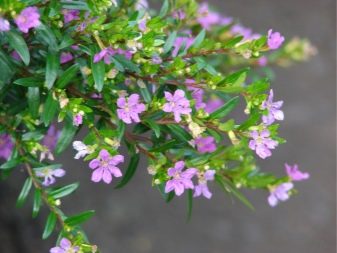
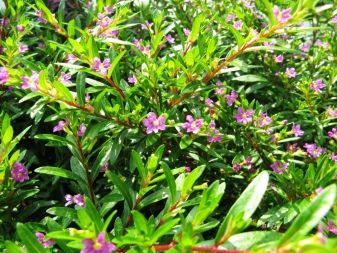
Kufeya fiery red
In height, representatives of this variety can reach a maximum of 40 centimeters. The lanceolate leaves of the shrub are oblong, can reach 5 centimeters in length, and their width can be 2-3 centimeters. In the arrangement of leaves on the shoots, the plant has the same order as in the previous variety of kufei. They are painted dark green. The flowers of this kufei are small, their diameter reaches a maximum of three centimeters.

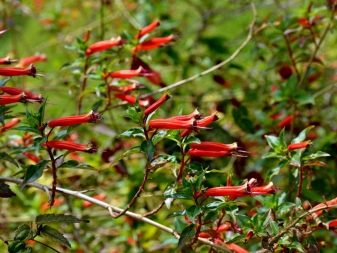
Llavea
Like many representatives of this species, the laveya is very fond of sunlight. It can grow even in deserts, as it does not need constant moisture and adapts perfectly to arid regions. The origin of this species is natural, unlike many other representatives of kufei. The average height of the bushes can be 30 centimeters.
The leaves of the kufei are elongated and painted in dark green tones. The edges of the leaves are decorated with small white villi. The buds are considered large, the length of one flower can be 2.5 centimeters. The flowers are painted a deep red, and the curved edges have a purple tint.

Shriracha
Usually, these representatives are colored in delicate colors, such as pink, raspberry or lilac. Representatives of this variety are very fond of high temperatures. The hybrids of such kufei are considered to be quite young varieties. Grows effectively at temperatures above +20 degrees. But cool summers won't be a big problem for flowers. The size of the bushes to some extent depends on the growing area, but on average they can reach a height of 30 centimeters.
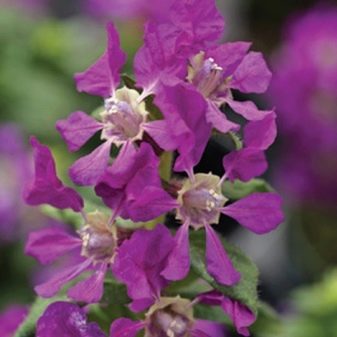
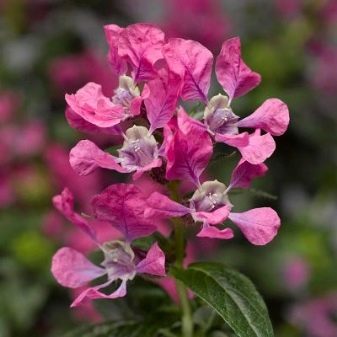
Diseases, pests and growing problems
Any problems with gofmanias are caused by improper care. Under optimal conditions and with quality care, pests are very rare. This plant is capricious, reacting painfully to improper care and dry air. Scabbards, felt insects and aphids are the most dangerous enemies of the plant. It is better to start fighting insect pests right away with insecticide treatment.
Fungal diseases cause no less problems. Any waterlogging, severe pollution of the leaves, inaccurate watering can result in the spread of rot. If signs of decay appear, you need to adjust the watering and start using fungicides.
Common growing problems:
- loss of leaf elasticity with too much watering;
- drying of the tips of the leaves in dry air or with changes in soil moisture;
- wilting due to improper watering or the spread of pests.
Gofmania is indoor. Marcella Scrimali
1.4 Top dressing
Regular liquid fertilizer once a month during the growing season.
Appointment.
Up in the menu
It is interesting: White-flowered Gemantus - description and features of cultivation, home care, photo

